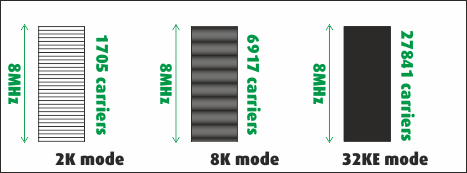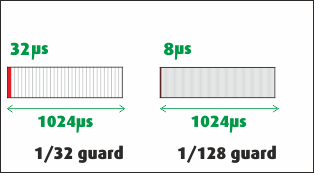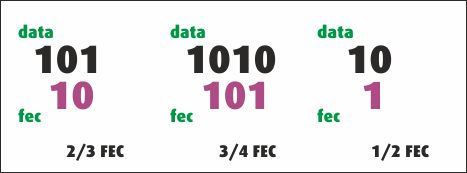Freeview modes - a simplified explanation
 Brian Butterworth published on UK Free TV
Brian Butterworth published on UK Free TV As mentioned in How digital television works Freeview signals can be broadcast in a number of different "modes", which are a combination of five parameters. Some of these have changed over the years because the increase in computing power has made more efficient methods of broadcasting cheap enough to fit in a set-top box - it is now possible to broadcast high definition television or more standard definition services on the same physical wavelength.
As some of the ideas that are implemented would fill a text book by themselves, I have presented the concepts in a simplified way.
Sub-carriers
Each Freeview multiplex is broadcast within an 8MHz channel that was originally allocated to analogue television. Rather than being a single broadcast, the channel is split into a number of different signals that sit next to each other.The original digital terrestrial broadcasts (from the launch of ONdigital) used 1,705 sub signals (referred to as 2k mode) about 4,600 Hz apart. After switchover 6,817 subcarriers (8k mode) means the signals are 1,170 Hz apart, with the high definition service using 27,841 (32ke) subcarriers just 280Hz apart.

It is possible to space carriers so close together because they are carrying digital information, in the analogue domain the problem with sidebands would render a similar system useless.
Symbol duration
For reasons detailed below, the information is not transmitted in single bits on each carrier, but as groups of bits which are referred to as "symbols". Each symbol is held in the transmission system for a given duration, 1024 us. The longer this time is, the less information is carried, but too short a duration for each symbol would not allow the receiver to detect the information correctly.Guard interval
Each subcarrier also uses a guard interval, which turns off each carrier as part of the transmission cycle. With SD broadcasts, this is 1/32th of the symbol time (32us), on HD it is 1/128th (8us). The guard intervals start each symbol and exist to deal with the problems of multipath - where the signal is being received directly and also by reflections.
Forward error correction
In non-synchronous digital transmission systems, such as those used for the internet, the presence of data corruption between the sender and receiver can be signalled back to the source and the data resent.However, a digital broadcast is a one-to-many unidirectional system, with no ability to ask for data to be resent.
For this reason, the transmissions use "forward error correction", which is a system that allows a certain level of errors to be detected.
The most basic form of a forward error correction (FEC) would be to transmit each bit twice - as long as each bit was sent along a separate subcarrier, then a single bit loss on one carrier could corrected by using the one sent on the other carrier. However, this is very inefficient, as it reduces the useful capacity of the system by half.

So, instead the DVB-T system uses a Punctured Convolution coding system. Instead of sending each bit twice, bits are grouped and then a code that describes the bits in a way that a single bit error can be detected and corrected most of the time.
Quadrature amplitude modulation
In the above descriptions, the word "symbol" was used to describe what is transmitted. You may have thought that a digital system would transmit information on the subcarriers as bits. However, doing this in a broadcast system is actually unproductive.For this reason, quadrature amplitude modulation is used. This takes the incoming bits and encodes them in groups. The most basic form encodes bits two at a time, using sine (Q) and cosine (I) functions that are then added to the main carrier. In effect "00" is encoded as -Q-I, "11" as +Q+I, with "01" and "10" being +Q-I and -Q+I.

At the next level, as used for DVB-T, the bits are encoded in groups of four bits (16QAM) or eight bits (64QAM), with DVB-T2 being groups of 16 bits (256QAM).
UK Freeview modes
There are 10 modes defined for use in the UK, these are:- Mode 1: DVB-T 1705 (2K) carriers, 64QAM mode, FEC=2/3, 1/32 guard = 24.13Mbps
- Mode 2: DVB-T 1705 (2K) carriers, 16QAM mode, FEC=3/4, 1/32 guard = 18.1Mbps
- Mode 3: DVB-T 6817 (8K) carriers, 64QAM mode, FEC=2/3, 1/32 guard = 24.1Mbps
Mode 4: DVB-T2 6913 (8KE) carriers, 64QAM mode, FEC=4/5, 1/32 guard = 34.7MbpsunusedMode 5: DVB-T2 27841 (32KE) carriers, 256QAM mode, FEC=3/5, 1/128 guard = 36.1Mbpsunused- Mode 6: DVB-T2 27841 (32KE) carriers, 256QAM mode, FEC=2/3, 1/128 guard = 40.2Mbps
- Mode 7: DVB-T 6817 (8K) carriers, QSPK mode, FEC=1/2, 1/32 guard = 6.0Mbps
- Mode 8: DVB-T 6817 (8K) carriers, 64QAM mode, FEC=3/4, 1/32 guard = 27.1Mbps
"high capacity commercial multiplex mode". Mode 9: DVB-T2 27265 (32KN) carriers, 256QAM mode, FEC=3/5, 1/128 guard = 35.2Mbpsunused- Mode 10: DVB-T2 27265 (32KN) carriers, 256QAM mode, FEC=2/3, 1/128 guard = 39.2Mbps
- Mode 11: "Northern Ireland mode" details TBC
Diagram showing capacity for each mode:

Help with Television sets?
Monday, 21 January 2013
S
Sally Ahmed9:59 PM
London
I have just bought a new tv and channel 83 Al-jazeera and 85 Russia today are breaking up. I live in Edmonton, London N18 and when i press the info button on these channels it says that they are on CH28. Is this the correct channel for these programs? Itv1 and Channel 4 were breaking up after having first tuned in the tv and i realised that the tv kept incorrectly picking up ch56 so i manually retuned them and they are now fine. It is just al-jazeera and russia today that i have problems with.
| link to this comment |
Sally's: mapS's Freeview map terrainS's terrain plot wavesS's frequency data S's Freeview Detailed Coverage
Tuesday, 22 January 2013
Sally Ahmed: When using the automatic tuning you should be able to avoid other transmitters, such as Edmonton's ITV/C4 etc which is on C57, by having the aerial lead unplugged after the first 30% of the scan.
C28 is correct for Crystal Palace. Judging by the prediction from Digital UK, you could perhaps potentially be getting a signal going into your tuner which is on the high or perhaps excessive side.
See:
Freeview signals: too much of a good thing is bad for you | Digital switchover | ukfree.tv - 10 years of independent, free digital TV advice
| link to this comment |
S
Sally Ahmed5:33 PM
London
Sally Ahmed: I have retuned and the picture is now not breaking. However the signal strength on all channels is 100% and the quality on all channels except C28 are also 100%. However the quality on c28 is only around 40-45%. Not sure why this is or how i can improve this. Thanks again
| link to this comment |
Sally's: mapS's Freeview map terrainS's terrain plot wavesS's frequency data S's Freeview Detailed Coverage
S
Sally Ahmed5:36 PM
London
Sally Ahmed: I stand corrected the quality on these channels now seem to have improved aand are around 90-95%. Thanks
| link to this comment |
Sally's: mapS's Freeview map terrainS's terrain plot wavesS's frequency data S's Freeview Detailed Coverage
Sally Ahmed: What you are describing could be as a result of the signal being too high. The effects of this appear the same as a signal that is not strong enough and/or not of sufficient quality due to the fact that the receiver gives false readings because its circuitry is being overwhelmed by signal.
Signal strengths vary a bit over time and it could be that it has relented a little. The trick is to ensure that natural variances in signal strength does not push it OTT.
Remove any booster and if there is no booster install some attenuation. I referred you to a page with some more information on this (see above).
| link to this comment |
Monday, 28 January 2013
S
Sally Ahmed6:52 PM
London
Sally Ahmed: Ok. Yesterday all channels on C28 (and only this channel)were freezing and breaking up. After having done a re-tune it corrected the problem. But my question is why would it just suddenly out of the blue need retuning, no-one had touched it or fiddled with it? This is the second time that this has happened. Could it be a fault with the tv even though it is only 2 weeks old?
| link to this comment |
Sally's: mapS's Freeview map terrainS's terrain plot wavesS's frequency data S's Freeview Detailed Coverage
K
KMJ,Derby9:01 PM
Sally Ahmed: It could be the negative offset that this mux has, resulting in the frequency reverting to C28 and therefore off-tune on the occasions you have mentioned. The other standard definition muxes use exact UHF channel frequencies.
| link to this comment |
J
jb389:09 PM
Sally Ahmed: Once a TV or box has been tuned it should never require re-tuning at any time unless pre-notified changes have been made at the transmitter station.
The next time this happens do not carry out an auto-tune but carry out a signal check on the programme EPG number in question, do this even if the screen is blank as the signal will still be there.
Maybe you could mention what the model number is of your new TV?
| link to this comment |
K
KMJ,Derby10:03 PM
Sally Ahmed: Further to the post of jb38 and myself above, when doing a signal check, observe the frequency that has been stored for the errant mux. If your receiver is one that does automatic re-tunes at set intervals it is possible that C48 from Sandy Heath is being selected, with resulting poor reception as mentioned. If this is found to be the case this facility should be turned off if possible.
| link to this comment |
Saturday, 30 March 2013
E
Emma10:13 PM
Free view: we've had a retune on 27/03/13 in the Bristol area. Since them whenever my freeview box turns off (either manually or after recording a programme) I lose the signal on all BBC channels, so I don't get to record or watch my programmes. I've tetuned more times than I care to mention. Ut don't know what else to do. I've a Sony hard drive recorder about 4 years old; it's been retuned out of necessary before but at the moment it needs retuning every time I want to watch or record BBC!
| link to this comment |
Select more comments
Your comment please!